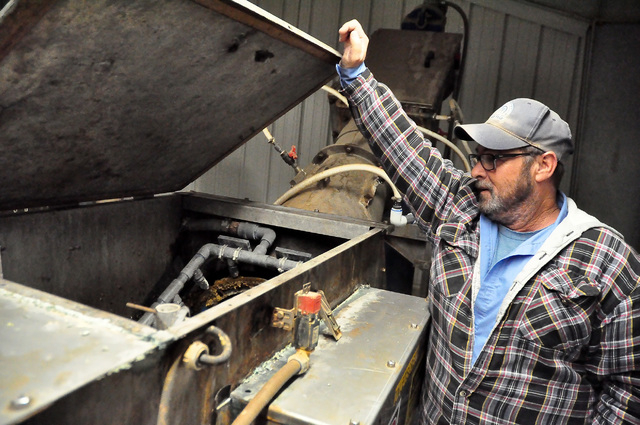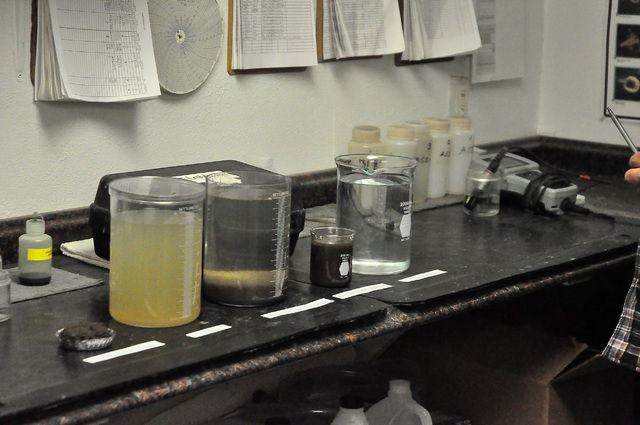UICN gives tours to residents, officials
In an effort to address persistent safety concerns associated with its proposed rapid infiltration system, Utilities, Inc. of Central Nevada recently held several tours for the public and officials at its wastewater treatment facility in Pahrump.
For several months, Pahrump officials have been wrangling over questions about the benefits of rapid infiltration basins, otherwise known as RIBs, that have been fueled by public concerns about water contamination with pharmaceuticals and other substances.
William Coates, area manager for UICN, sought to quell those concerns during the tour at the UICN’s wastewater treatment plant No.3 that was organized for the Pahrump Valley Times on Monday. He said RIBs were the “only alternative” that had been been approved by the Nevada Department of Environmental Protection.
“It’s another way of recharging the water and reusing it and putting it to good use after it’s been safely treated,” he said about RIBs.
During the tour on Monday, Coates showed the several steps of the water treatment process that takes place at the facility, starting with screening out all of the nonbiodegradable materials during the pretreatment process and finishing with clean water after chlorination.
He said the water is treated to 90-95 percent removal of carbonaceous biochemical oxygen demand (CBOD) and total suspended solids (TSS) — the two indicators of pollutants in wastewater.
“We also require to remove total nitrogen of less than 10 milligrams per liter,” Coates added.
In a small laboratory onsite, UICN employees conduct daily testings for alkalinity, acidity and chlorine in wastewater.
“This is done every day, seven days a week, this plant is manned seven days a week, 365 days a year,” he said.
“If you put that to a glass of water, you will almost not be able to tell the difference,” Coates said pointing at the glass of processed water. “Except you would probably smell some chlorine in this that you wouldn’t smell in drinking water.”
UICN has been arguing that the proposed RIBs would provide additional treatment through the trickling through the groundwater and the natural bacteria.
Coates said the system would operate approximately five months a year when the temperatures are cooler and the need to distribute reclaimed effluent is lower than in summer months.
“The water that we try to use in the winter, the Lakeview Golf Course does not take as much because of the temperature, the evaporation rates are down, the grass, the turf does not need that much water and it’s not being uptaken and the ponds that we have throughout the property do not require as much water to maintain the levels,” he said.
Pahrump Utility Company Inc., and Desert Utilities Inc., both operate RIBs.
Coates said the unlined ponds near UICN are already infiltrating and percolating into the groundwater since the Willow Creek Golf Course was built.
“If there was going to be any adverse effect, it would have shown up by the already existing ponds,” he said.
The NDEP will require monitoring groundwater through monitoring wells. UICN has yet to make a decision on where to put them.
Near wastewater treatment plant No.3, UICN is constructing a new reclaim pond and also reconstructing the one that was let go by the previous owner of the Willow Creek Golf Course. The construction of those two ponds is going to be dependent upon RIBs, Coates said.
“(They) are going to be another alternative to disposing effluent, the treated effluent,” he said.
But as the UICN’s wastewater treatment plant No. 3 is looking to add more volume, Coates said there will be a need for more RIBs.
“The current two RIBs that are going in are only for the current flows of the plant, which is around 650,000 gallons of water a day average flow. The plant is ready for 1.5 million gallons a day. Eventually, there will have to be two more RIBs planned to be added at a later date,” he said.
“All safety concerns are relevant, it’s just that I think some of these are to the extreme because the RIBs are already existing in this county and there’s been no adverse effect,” he said.
Contact reporter Daria Sokolova at dsokolova@pvtimes.com


















